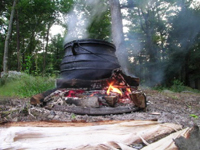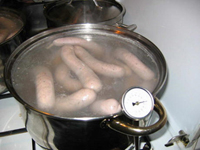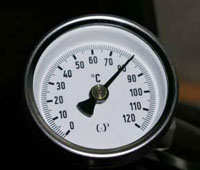Meats and Sausages
Cooking Sausages
Sausages, hams, and other pieces of meat are considered raw products unless h,eated to an internal temperature of about 154º F (68º C), and it is of no importance whether it is done by boiling, steaming, grilling, or baking. A sausage might be smoked at 100º F for 6 hrs, and it will have a great smoky taste, flavor, and color, but it will still be a raw sausage, like a fresh sausage that was only ground, mixed with spices and stuffed into casings. Both of them must be cooked to a safe temperature before consumption. Fats start to melt at 95-104° F (35-40° C) and going over 170° F (76° C) internal meat temperature will decrease the quality of the sausage. Staying within 154-160° F (68-72° C) will produce the highest quality product.
Special sausages such as blood sausage, liver sausage, and head cheese have their ingredients pre-cooked before being minced, mixed, and stuffed. Different cuts like skins, tongues, or jowls require different cooking times, so it may seem that many pots might be needed. The solution is to use one pot but place the meats in separate bags made of netting. Each bag is removed as soon as the meat is cooked sufficiently. The leftover stock should be saved and used as a cooking medium, as these sausages are cooked in water. Remember that meat stock may have a hot layer of fat on top, and floating on top sausages may burst open. If not enough stock remains, add more water. After sausages are cooked, the remaining stock may be used for soup.
Cooking in a Smoker
It makes sense to cook smoked meat in the smoker as it is already there. Besides, it will taste slightly better than using the poaching method, and it will shine more. On the downside, it will lose more weight than other methods. It is also the slowest and the most difficult method that largely depends on the technical possibilities of the smoker and how well it is insulated. A slowly increasing temperature inside the smoker will achieve the best effects. The smoking process is relatively fast, and a typical 36 mm sausage will be smoked in about 1.5-2 hours. Depending on the temperature when the smoking process has ended, such a sausage may be cooked to the safe internal temperature of 68° C (154° F) in 30 minutes or a few hours.
While it takes 1-2 hours to smoke a sausage, it may take an additional 2 hours to cook it inside the smoker. It will largely depend on the inside temperature of the meat when smoking is stopped. If it was 100° F (38° C) we have a long way to go, if it was 150° F (66° C) we are almost there. That shows a need for intelligent planning, and it is advisable to increase the smoking temperature to about 160° F slowly. When smoking is done, the temperature should be increased to 170° F (77° C) and maintained at that level until the inside temperature of the smoked meat reaches 154° F (68° C).
As most products are hot smoked today, the cooking process will be relatively short. It is a good idea to start raising the smoking temperature within the last hour of smoking to finish smoking at a high temperature. Actually, cooking may become part of the smoking process itself, and the smoke may end at 68° C (154° F), making the product both smoked and cooked. A lot will depend on outside conditions and how well the smoker is insulated. That may be difficult to achieve sometimes thus, we may need to increase the temperature of a smoker to about 185° F (85° C) to bring the internal temperature of the meat to the required level. Cooking can also be accomplished in the kitchen oven, although in the electric type, the lowest thermostat setting often begins at 88° C (190° F). A higher temperature is definitely not recommended.
The other easier method is to set the temperature of the smoker to 77-80° C (170-176° F) and wait until the meat’s inside temperature reaches 154° F (68° C). Remember that the smokehouse temperature is around 25 degrees higher than the temperature inside the meat, but that largely depends on the meat’s diameter. Two thermometers are needed: one to monitor the temperature of the smoker, cooking pot or oven (oven has its own temperature dial), and the other to monitor the inside temperature of the meat or sausage in its thickest part. It helps to have a thermometer with an alarm sounder; this way, we get an audible warning when the meat reaches its pre-set temperature.
Cooking in Water
People seldom realize that most sausages, including smoked ones, are cooked in hot water (around 80º C, 176º F), which on average takes 15-60 minutes, depending on the diameter of the product. Cooking in water is much faster than baking, and maintaining temperature is easier. This is due to the fact that water conducts heat more efficiently than air. Water is brought to a boil, the sausages are inserted, the heat is lowered, and the temperature is maintained at 80° C ( 176° F).
A rule of thumb calls for about 30 minutes per pound, depending on the cooking temperature. Some recipes call for preheating the water before adding the sausages and some call for adding the sausages to cold water. Most people prefer the latter method. The water should be heated rapidly to 175-185° F (80-85° C). At 176° F (80° C), the sausages are cooked for 10-120 minutes, depending on the type and size of the product. It is generally accepted that 10 minutes are needed for each 1 cm of the width (diameter) of the sausage.
Poaching times for products up to 60 mm in diameter:
| Typical sausage | 10 min per 1 cm | Sausage 30 mm diameter is cooked 30 minutes |
| Liver sausage | 12 min per 1 cm | Sausage 50 mm in diameter is cooked 60 minutes |
| Blood sausage | 15 min per 1 cm | Sausage 40 mm in diameter is cooked 60 minutes |
Once the diameter of the sausage is larger than 60 mm, the above times are less accurate and should be increased. Double up the time, it is better to be safe than sorry. For example pork stomach may be cooked for 2-3 hours. The best solution is to use a meat thermometer. Cooking in water is a good method for sausages that are smoked with hot smoke. The short hot smoking process creates a dry layer on the outside of the sausage, similar to a second skin, that prevents the migration of moisture and juices from the inside of the sausage to the water in the pot. A cooking pot remains uncovered during cooking.
A sausage may contain air that got in during the stuffing process. Such a sausage will swim up to the surface; the remedy is to prick it with a needle. This will, unfortunately, permit some of the meat juice to migrate into the water. This is another reason why many people save this stock for making soups. A good solution is to construct a grid-shaped wooden cover fit to the diameter of a cooking vessel. Such cover is placed on top of sausages to keep them submerged. The cover can be used during cooling sausages as well.
Cooking meats and sausages in hot water is more convenient than baking in hot air. Water in an open container at sea level will always boil at 212° F (100° C) and no higher. This precisely controls the maximum temperature that can be obtained using the simplest equipment. When baking, we depend more on the technical capabilities of the smoker or the oven, and more supervision is required.
Baking in the Oven
You can bake your meat or sausages in the oven as long as your unit can maintain temperatures of 195° F or lower. If the oven’s lowest temperature exceeds 195° F (90° C), switch to cooking in water. Baking sausages in a smokehouse is less efficient than cooking in water, but they look better having a glossy look on the outside. This is due to the melted fat that moved to the surface where it resides as a thin coat of grease. It is like putting grease on a pair of boots, they are going to shine and look better. Besides the looks, the flavor of a baked sausage is also slightly better as there was no loss of meat juices, which in the case of poached sausages will migrate to the water. The disadvantage is that the baked sausage loses more weight than the sausage poached in water.
To sum it up: anything falling within 154º – 160º F (68º - 71º C) is cooked to a safe temperature, the Government recommends 160º F and there is absolutely no reason whatsoever to go any higher. For a home sausage maker the inside temperature of the meat should fall between 154º – 160º F. We can stop cooking at 154º F (67º C) as most products will be of smoked variety and thus previously cured with salt and nitrite, which gives us considerably more safety. Fresh sausages and meats which were not previously cured, will not be smoked, just cooked before consumption and the recommended temperature of 160º F should be observed.The lower the cooking temperature, the juicier and tastier the product and the smaller the weight loss



















